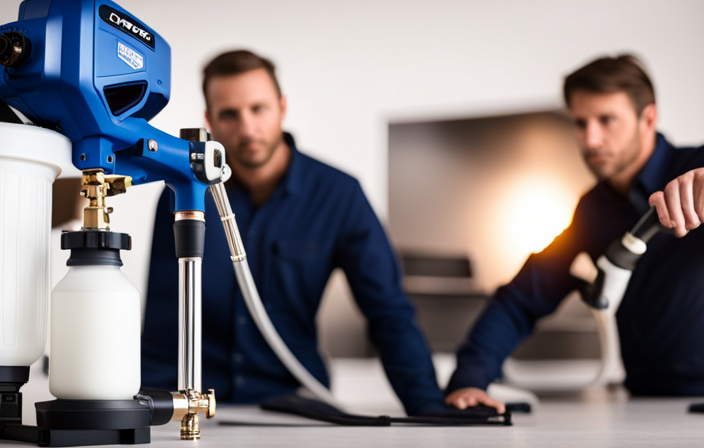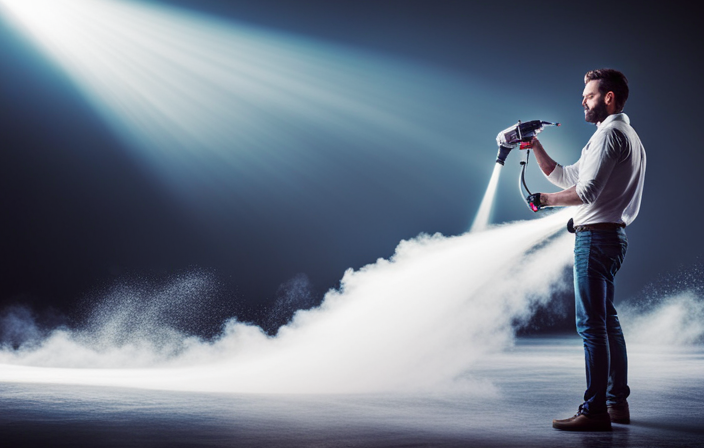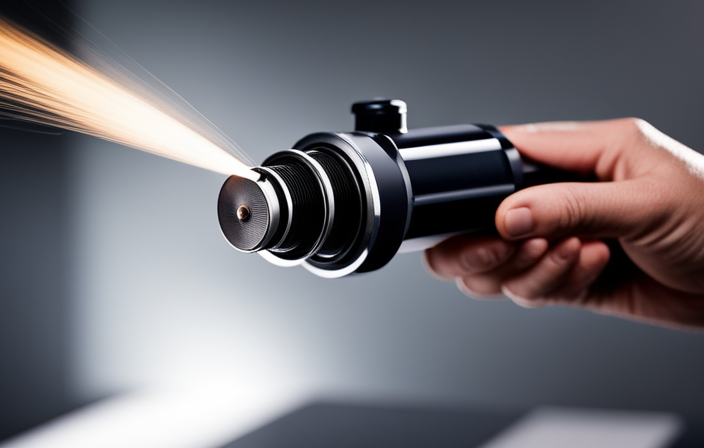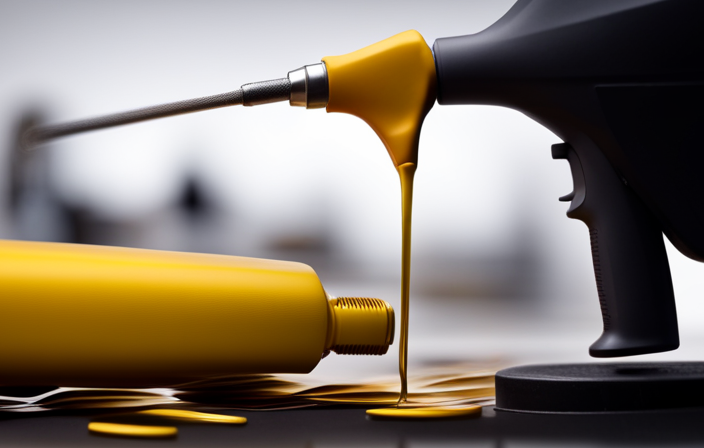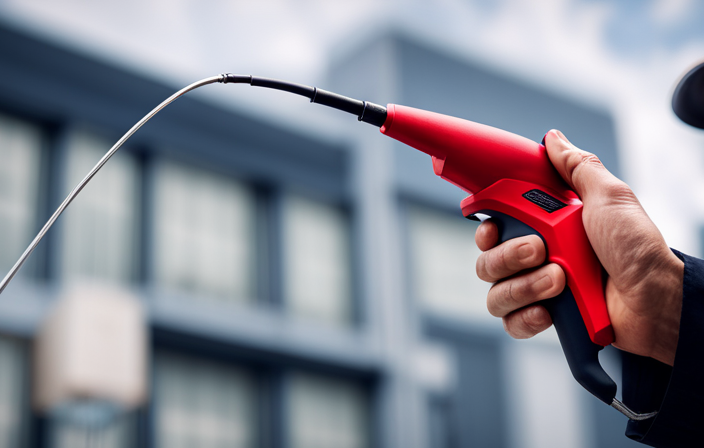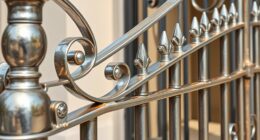Have you ever found yourself facing a variety of airless paint sprayer nozzles, feeling overwhelmed and unsure of where to start? Trust me, I’ve been there too.
It’s like staring into a sea of numbers and sizes, trying to decipher their meaning. But fear not! In this article, I’m going to be your guide, helping you navigate through the confusing world of airless paint sprayer tip sizes.
Think of it as finding the perfect brush for your masterpiece. Each tip size has its own purpose and can make a significant difference in the outcome of your painting project.
From the tiniest details to large coverage areas, understanding how to read and choose the right tip size is crucial.
So, grab your paint sprayer and let’s dive into the world of airless paint sprayer tip sizes, demystifying the numbers and equipping you with the knowledge to achieve flawless results.
Key Takeaways
- Airless paint sprayer tips are labeled with numbers that indicate the tip size
- Smaller tip sizes are used for precise and detailed work, while larger tip sizes are used for faster coverage on larger surfaces
- Examples of smaller tip sizes include 311 and 313, while examples of larger tip sizes include 517 and 519
- Experimenting with different tip sizes can help achieve the perfect spray pattern for different painting techniques
Understanding the Measurement System for Airless Paint Sprayer Tips
If you’re ready to dive into the world of airless paint sprayer tips, let’s break down the measurement system so you can confidently choose the right size for your painting projects!
The measurement system for airless paint sprayer tips is based on two key factors: the fan width and the orifice size. The fan width refers to the width of the spray pattern, while the orifice size determines the flow rate of the paint.
The measurement system uses a three-digit number to represent these factors. The first digit represents the fan width, and the last two digits indicate the orifice size in thousandths of an inch. For example, a tip with the number 515 would have a fan width of 5 inches and an orifice size of 0.015 inches.
Understanding this measurement system is crucial for selecting the right tip size for your painting project. It ensures that the paint is applied evenly and efficiently.
Moving on to the importance of choosing the right size for your painting project, it is essential to consider factors such as the type of surface, desired finish, and the type of paint being used.
Importance of Choosing the Right Size for Your Painting Project
Selecting the appropriate dimensions is crucial when it comes to achieving optimal results for your artistic endeavor. When choosing the appropriate nozzle for your airless paint sprayer, it’s important to consider the size that will best suit your painting project.
The size of the nozzle determines the spray pattern, which directly affects the coverage and finish of your paint job. A smaller nozzle size will create a narrow spray pattern, ideal for detailed and precise work. On the other hand, a larger nozzle size will produce a wider spray pattern, making it suitable for larger areas.
Understanding the spray pattern and choosing the appropriate nozzle size will ensure that your painting project is completed efficiently and with excellent results.
Now, let’s move on to learning how to read the numbers on airless paint sprayer tips.
How to Read the Numbers on Airless Paint Sprayer Tips
To fully understand which nozzle size is best for your painting project, it’s helpful to know how to interpret the numbers on the airless paint sprayer tips.
The numbers on the tips indicate the orifice size, which determines the flow rate and fan width. Understanding tip compatibility is crucial to ensure that the tip you choose is compatible with your airless paint sprayer.
The first number on the tip represents the fan width in inches, while the second number indicates the orifice size in thousandths of an inch. For example, a tip with the numbers 515 means it has a fan width of 5 inches and an orifice size of 0.015 inches.
Troubleshooting common tip issues, such as clogging or uneven spray patterns, can be resolved by selecting the correct tip size. With this knowledge, let’s move on to tips and tricks for selecting the correct tip size for your painting needs.
Tips and Tricks for Selecting the Correct Tip Size
When choosing the right tip size for your project, remember to consider the desired coverage and flow rate of the paint. To ensure efficient paint spraying, here are some tips for selecting the correct tip size:
-
Match the tip size to the type of paint you’re using. Thicker paints typically require larger tip sizes, while thinner paints work best with smaller tip sizes.
-
Consider the surface you’re painting. Rough surfaces may require larger tip sizes to achieve proper coverage.
-
Take into account the size of the project. Larger projects may benefit from larger tip sizes to increase productivity.
-
Be mindful of the desired spray pattern. Different tip sizes produce different spray patterns, so choose the one that best suits your needs.
-
Experiment and test different tip sizes to find the one that provides the desired results.
Considering these factors will help you choose the appropriate tip size for your paint sprayer.
Transitioning into the next section, let’s discuss the factors to consider when choosing the size of your paint sprayer tip.
Factors to Consider When Choosing the Size of Your Paint Sprayer Tip
Considering the factors that affect the size of your paint sprayer tip will help you achieve the desired results for your project. When selecting the right size, there are several factors to consider. Firstly, the type of paint you are using plays a crucial role. Thicker paints require larger tip sizes for better coverage, while thinner paints work well with smaller tip sizes. Secondly, the surface you are painting on is important. Rough surfaces may require larger tip sizes to ensure even coverage. Additionally, the desired finish and coverage also influence the tip size. A larger tip size will result in a thicker coating, while a smaller tip size will provide a finer finish. By considering these factors, you can select the perfect tip size for your project, achieving the desired finish and coverage effortlessly.
Achieving the Desired Finish and Coverage with the Right Tip Size
Imagine you’re an artist wielding a magical wand, and the size of your wand’s tip determines the texture and depth of your masterpiece. Similarly, selecting the appropriate nozzle size for your airless paint sprayer is crucial in achieving even paint distribution and the desired finish.
Here are four key factors to consider:
-
Coverage: A smaller tip size is ideal for detailed work and achieving a fine finish, while a larger tip size is better for covering larger areas quickly.
-
Material: Different materials require different tip sizes for optimal performance. Thicker materials like latex paint may require a larger tip size to avoid clogging.
-
Pressure: Adjusting the pressure on your paint sprayer can also affect the spray pattern and coverage. Experimenting with different pressures can help you achieve the desired result.
-
Surface: The texture and condition of the surface you’re painting can impact the tip size you should use. Rough surfaces may require a larger tip size to ensure proper coverage.
By selecting the appropriate nozzle size, you can achieve even paint distribution and create a masterpiece. However, it’s important to avoid common mistakes when using airless paint sprayer tips.
Common Mistakes to Avoid When Using Airless Paint Sprayer Tips
Avoiding common errors is essential when utilizing the tips for your airless paint sprayer to ensure a flawless painting experience. It’s important to be aware of common misconceptions and troubleshooting tips to avoid any mistakes. One common mistake is using the wrong tip size for the job. This can lead to poor coverage or overspray. Another mistake is not properly cleaning and maintaining the tip, which can result in clogs and uneven spray patterns. Additionally, not adjusting the pressure correctly can cause issues with the paint flow and finish. To help you avoid these mistakes, refer to the table below for some troubleshooting tips:
| Common Mistake | Troubleshooting Tip |
|---|---|
| Using wrong tip size | Refer to the manufacturer’s guidelines |
| Not cleaning tip | Use a cleaning solution and a brush |
| Incorrect pressure | Adjust the pressure according to the paint |
By being aware of these common mistakes and following the troubleshooting tips, you can achieve a flawless painting experience. Now, let’s move on to the next section about adjusting spray patterns with different tip sizes.
Adjusting Spray Patterns with Different Tip Sizes
To achieve mind-blowing spray patterns, simply adjust the tip size on your airless paint sprayer. The size of the tip determines the width of the spray pattern, and it can be easily changed to suit your painting needs.
If you’re experiencing issues with your spray pattern, such as uneven coverage or overspray, adjusting the tip size might be the solution. Start by troubleshooting the spray pressure to ensure it’s set correctly. Then, try using a smaller tip size for more precise and detailed work, or a larger tip size for faster coverage on larger surfaces.
By experimenting with different tip sizes, you can achieve the perfect spray pattern for any painting project.
Now, let’s move on to cleaning and maintaining your airless paint sprayer tips.
Cleaning and Maintaining Your Airless Paint Sprayer Tips
Properly maintaining your airless paint sprayer is essential for achieving flawless spray patterns. Cleaning your airless paint sprayer tips regularly is crucial to prevent clogs and ensure optimal performance.
To clean the tips, start by removing them from the sprayer and soaking them in a cleaning solution. Use a small brush or toothpick to remove any dried paint or debris. Rinse the tips thoroughly with water and let them dry before reattaching them to the sprayer.
If you encounter any issues with your sprayer, such as uneven spray patterns or reduced pressure, troubleshooting tips can help. Check for clogs or blockages in the tips or filters, and clean or replace them if necessary.
Regular cleaning and maintenance will keep your airless paint sprayer in top condition for all your painting projects.
Transitioning into the next section, expert recommendations for different painting applications can further enhance your painting experience.
Expert Recommendations for Different Painting Applications
For a flawless finish, expert recommendations can guide you like a compass through different painting applications.
When it comes to painting techniques, it’s important to choose the right airless paint sprayer tip size for the job. For fine finishes and detailed work, a smaller tip size, such as a 311 or 313, is recommended. These tips produce a narrower spray pattern, allowing for more control and precision.
On the other hand, for larger surfaces and faster coverage, a larger tip size, like a 517 or 519, is preferred. These tips provide a wider spray pattern, making it easier to cover larger areas more quickly.
Additionally, it’s important to troubleshoot any issues that may arise during painting. If you experience clogging or uneven spray, try cleaning the tip and adjusting the pressure.
Following these expert recommendations and troubleshooting tips will help you achieve professional-looking results every time.
Frequently Asked Questions
Can I use the same tip size for different types of paint?
Yes, you can use the same tip size for different types of paint. However, it’s important to consider the surface you’re painting. Different surfaces may require different tip sizes for optimal coverage and finish. Tips for cleaning airless paint sprayer tips are also essential to maintain their performance.
How often should I replace my airless paint sprayer tip?
Replacing airless paint sprayer tips is as rare as finding a needle in a haystack. To prolong their lifespan, clean them properly after each use. Remove any clogs and debris to ensure optimal performance.
Can I use a smaller tip size to save paint?
Using a smaller tip on an airless paint sprayer can save paint, but it may lead to potential drawbacks. A smaller tip can result in uneven coverage and require more coats, leading to longer painting times.
What is the maximum thickness of paint that can be used with an airless paint sprayer tip?
The maximum thickness of paint that can be used with an airless paint sprayer tip depends on its compatibility with different types of paints. It’s important to choose the right tip size for optimal results.
Can I use different tip sizes for different parts of a painting project?
Yes, you can use different tip sizes for different parts of a painting project. Proper tip selection is important because it determines the spray pattern. Different spray patterns are needed for different areas, such as corners or large surfaces.
Conclusion
In conclusion, understanding how to read the sizes on airless paint sprayer tips is crucial for achieving the best results in your painting projects. By choosing the right size, you can ensure an even and professional finish.
Remember to consider factors such as the type of paint, surface, and desired spray pattern when selecting the tip size. Avoid common mistakes and regularly clean and maintain your sprayer tips for optimal performance.
With expert recommendations and a little practice, you’ll be able to tackle any painting application with confidence and precision.

